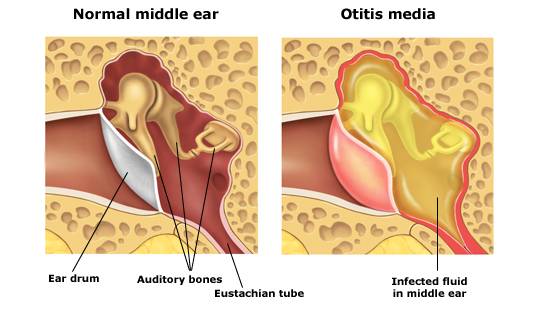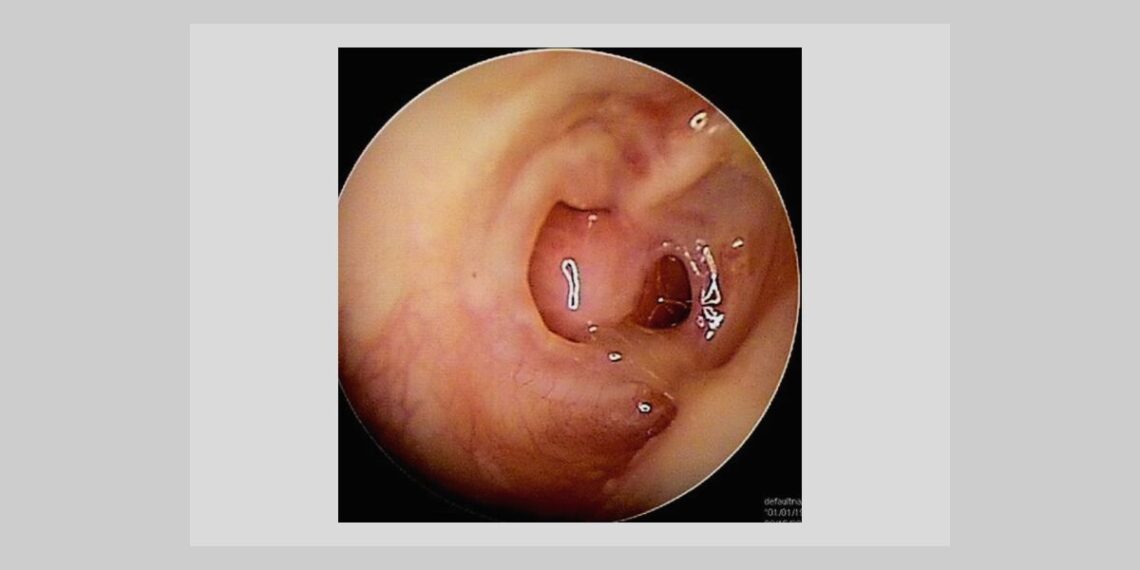
The two leading symptoms are the discharges and the deafness. Allow me to call your attention to a term found very frequently in our literature, which is used to designate a disease, — otorrhoea. This is the name, not of a disease, but simply of a symptom of a disease. The make- up of the word, as you understand, indicates its meaning, — ‘a flow from the ear”. As regards the nature of this discharge, it may be said that it is marked by all the shades of difference between pure pus and a mucopurulent discharge which is more mucous than pus. The purulent discharge may also be laudable, bland, or ichorous, excoriating, sanguineous, and on these small points of difference is based the prescription of various remedies.
The deafness is in marked contrast to that in many cases of chronic catarrhal inflammation. There are certain facts touching the calibre and length of the canal, the appearance of the membrana tympani, and of the mucous membrane of the cavity of the tympanum, if the drum head be perforated, which will, as objective symptoms, help you to distinguish between otitis externa and otitis media. Until the eye is educated, you may not be able to determine whether the granulation, ulceration, pus, or mucus, which is seen, is located in the canal, upon its walls, or upon the walls of the cavity of the tympanum.
Prognosis – The prognosis is unfavorable if the disease is allowed to take its course. It is certainly favorable under the best instrumental and medical treatment of today. I may state here, not in any spirit of egotism, but to emphasize an important truth, — that for more than seventeen years I can review the history of cases, and assert that where the parents, guardians, or others having the charge of patients, have persisted in maintaining the treatment year after year, in no instance have I failed to reach the desired result. In two cases, children who had suffered from scarlet fever, barely escaping with their lives, both membranae tympanorum lost, the suppurative process has been brought to an end ; and, by the use of a cotton pellet, these children, now young ladies, are able, with but little difficulty, to understand all ordinary conversation. In one case, however, it required nine years, and in the other, eight, to reach this much-desired issue.
Patients who have themselves made attempts at cleansing the cavity of the tympanum, have at times experienced a loss of sensation and taste on one-half of the tongue, and have been seriously alarmed at the results so produced. You will understand how this has been caused, when you consider the relation of the chorda tympani nerve to the branch of the facial, which passes through the upper portion of the tympanum. In cleansing the cavity, the surgeon may produce this symptom but it is usually of short duration, and need cause no special alarm. Vertigo may be produced in the same manner, or by the forcible use of the syringe. This is due to direct pressure, either upon the disarticulated stapes or the exposed fenestra rotunda, thereby causing change of the tension of the labyrinthine fluids. This is not usually a serious symptom but you must not allow this fact to make you unmindful of persistent vertigo, associated with suppurative disease of the middle ear, as we shall see that it is one of the symptoms of necrosis, or caries of the labyrinth.
Remedies: The indications for the remedies will be found very largely pointed out, by studying the conditions of the nasopharynx and the Eustachian tube, as well as by considering the objective symptoms which present themselves in the meatus externus.
Calc phos is of great importance in scrofulous patients with enlarged tonsils and a tendency to grossness of tissue, or to involution of the periosteum, and cancelled tissue of the temporal bone. You have noticed, undoubtedly, that it is frequently prescribed for the poorly nourished children who present themselves at the clinic, those with large heads, large bones, and flabby tissues.
Cinchona has proved of more value in our hands, in cases of hemorrhage from the mucous membrane of the middle ear, than has any remedy laid down in our repertories. This is a matter of clinical experience, rather than pathogenetic etc and failing of satisfactory results in a particular case, I gave Cinchona in a low potency, on general principles, for the anaemic condition of the patient. To my great satisfaction, the patient’s condition not only improved, but the hemorrhage from the ear ceased and, from the exhibition of this remedy, an improved condition of the tissues began, which was carried to a successful issue by the administration of other remedies. This I believe to be the scope of Cinchona, and I use it intercurrent with calcarea phos., kali mur, psorinum, silica, tellurium or thuja.
Elaps is a valuable remedy in the case of children. The naso-pharynx is characterized by dryness of secretion. The mucous membrane of the posterior wall of the pharynx cracks, or is covered with dry crusts. The nares are obstructed, crusty, so that the child has what the old nurse calls “snuffles,” and, when sleeping, breathes with the mouth open. The discharge from the ear is thin, somewhat irritating, staining the bedclothes on which it chances to fall, a clear green color.
Hepar sulph calcarea is especially indicated in ulcerations, perforations, the particular indications being sensitiveness of the tissues.
Hydrastis canadensis is indicated by a bland discharge, which is more mucus than pus, associated with dropping, in the posterior nares, of a yellowish catarrhal secretion. Kali bichrom, is analogous to Hydrastis, has the muco-purulent nature of the secretion, but the tissues are more irritable, tending to bleeding or to crusts and the naso-pharyngeal tract manifests the same disposition.
Kali muriaticum is in my judgment, a good remedy for excessive granulations, and I have had more satisfaction from its use than from any other single remedy. In repeatedly occurring granulations on the inner third of the canal, about the edges of the perforations, or on the tympanic wall, I always expect improvement under this remedy, in conjunction with the local treatment which I have already laid down.
Mercurius sol has proved, in clinical experience, to be indicated by this characteristic : a coppery or metallic odor of the secretion, as well as by the well known naso-pharyngeal symptoms.
Psorinum has an extremely fetid discharge, associated with eczematous conditions about the ear, or in other parts of the body. You will compare it with tellurium and Thuya.
Sulphur is a valuable intercurrent remedy, and may be used when other remedies apparently fail to overcome the conditions for which they are clearly indicated, and its administration often serves to bring out, and render clear, conditions which were before obscure. The general symptoms of the integument should be noted carefully, to guide in the administration of this remedy.
Tellurium is indicated for conditions of the drum head similar to phlyctaenular conjunctivitis, the whole drum head appearing dark purple, with elevated spots at various points, which form vesicles, break, oozing a watery discharge, having the odor of fish-pickle, extremely acrid, excoriating the canal, and often the cheek.
The late Professor Carroll Dunham, M.D., made a heroic proving of this remedy, and called my attention to this effect on his own person, some years afterwards. Inspection of the drum head showed it to have been perforated, and afterwards repaired, the cicatrical tissue being quite extensive. This would argue that the remedy had much deeper action than merely upon the external surface of the drum-head. In fact, this has so proven in long standing cases, particularly in children.
Thuja is in decided contrast to other remedies mentioned, in that its discharge is bland, thick, the odor being that of putrid meat.
Excerpted from: Henry C. Houghton, MD – Lectures On Clinical Otology Delivered Before The Senior Class In The New-York Homceopathic Medical College 1855.





Merc sol is alos one of the medicines for the same.
Thanks for good article.
RIP
May God bless him.
Good afternoon doctor
I am 36 years old and i have discharge my ear about 30 years old. so may i know there is an any treatment in homopathay medicine. so then tell me.